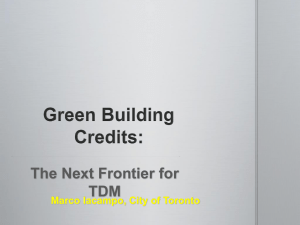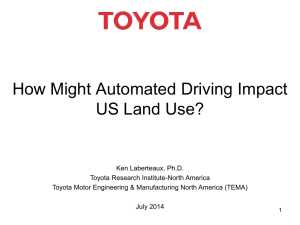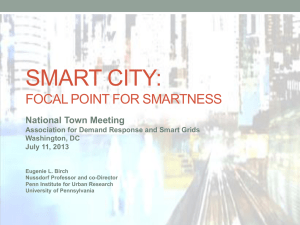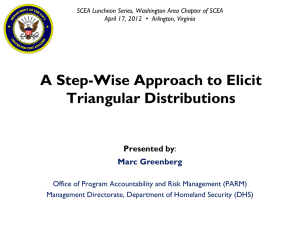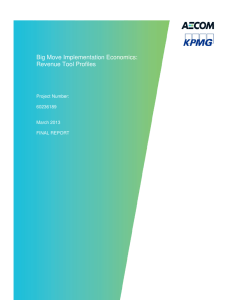11B Nadine Navarro - Smart Commute Metrolinx
advertisement
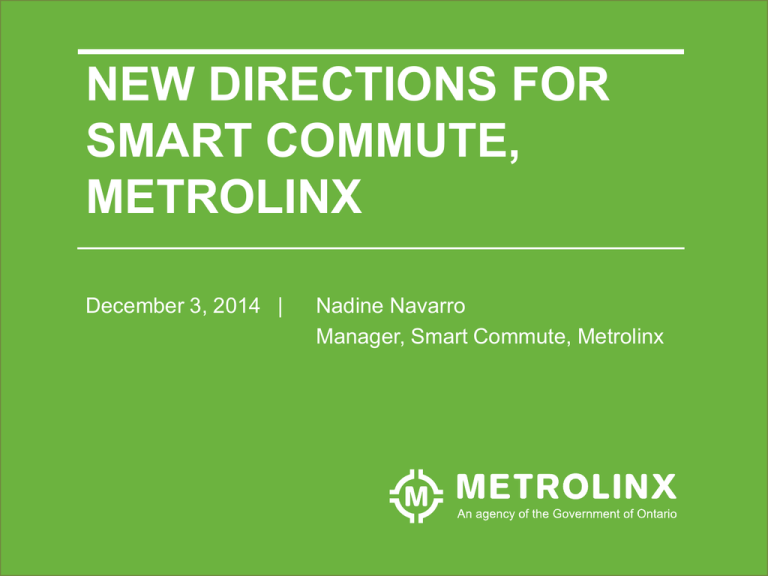
NEW DIRECTIONS FOR SMART COMMUTE, METROLINX December 3, 2014 | Nadine Navarro Manager, Smart Commute, Metrolinx Metrolinx Overview Key Business Units that help us fulfill our responsibilities to plan, deliver and operate: Policy, Planning & Innovation Capital Projects Plan Deliver Operate we shape the regional transportation system so it is modern, efficient and integrated, now and into the future we are builders, buyers and managers of infrastructure through our three operating divisions, we help the public move across our region every day, with a focus on customer service excellence 2 History of Smart Commute – Some Key Dates 1999 Establish Smart Commute Initiative 2001 First TMA - “Black Creek Regional Transportation Management Association” 2004 Transport Canada support ‘Smart Commute Initiative’: TMAs and central GTHA coordinating body ( “Smart Commute Association”); 2nd TMA in Markham/Richmond Hill 2008 Smart Commute Association joins Metrolinx: 10 TMAs, servicing 104 organizations; school travel program initiated, plus multi-municipal committee for region-wide TDM 2009 Start of the Stepping It Up, and Active and Sustainable School Travel program 2010 11 TMAs: Strategic goal to grow number of workplaces serviced by program 2014 13 TMAs; program is working with 340 workplaces 3 Smart Commute Workplace Program 4 TMA Models 5 Not for Profit • Governed by Board of Directors • In-house staff • Fees for services • Metrolinx + municipal + nongovernmental funding Board of Trade/ Chamber of Commerce • Governed by Board of Directors/ Chamber of Commerce, supported by Advisory Board • In-house staff • No fees for services • Primarily Metrolinx + municipal funding Non-Fee Municipal • Governed by municipality • Delivery may be procured • No fees for services • Metrolinx + municipal funding For- Fee Municipal • Governed by municipality • Delivery may be procured • Fees for services • Metrolinx + municipal + nongovernmental funding School Travel - Trends & Need for Action • 20% decrease in GTHA active school travel since 1986 Transportation To School Mode Share (1986-2011) Age 11-13 • Relationship between school travel & parental work commute • 20% of am peak hour traffic is connected to school travel • Our mandate: RTP vision of 60% of children walking or cycling to school by 2031 • Children today are the commuters of 2031 and beyond Source: R. Buliung U of T Journeys to School and Work (2014) using TTS Data 6 Why New Directions? TO2015 Developing the Five-Year Strategy Growth – Workplace Program Smart Commute Member Workplaces 8 Depth – Broader Mandate Our Vision & Mission Serve with Passion Play as a Team Think Forward MX Vision & Values Smart Commute Mission Workplace School Community Project Evaluation & Partnerships 9 Build & Strengthen Integrate Innovate Measure & Target Lead by example Build and Strengthen the Program Smart Commute Strategy 2014/15 - 2019/20 Smart Commute Strengthen Engagement with Workplaces 10 Delivery of TDM for School Travel TDM for Active and Sustainable Communities Integrate Fully integrate TDM into regional change opportunities Metrolinx Municipal + • Services • Goods movement and active travel • Stations • Integration of fares, • Local transit services, information • Local planning • Policy 11 Key Change Opportunities • TORONTO 2015 Pan/ Parapan Am Games • (Road network) Construction • Extreme weather events Innovate • Promote and encourage innovation for mobility and TDM solutions • Looking forward • Supporting a culture of innovation • Empowering partnerships • Seeking new ways to collaborate 12 Measure, Target and Communicate • Focus our efforts on initiatives that can best achieve and demonstrate behaviour change • Build evaluation into projects from the beginning • Apply new KPIs to measure performance • Develop Workplace Program Impact Assessment • Improve financial data • Introduce recognition and awards to reflect the entire program 13 Lead by Example • Deliver best practice in-house • Learn from our experiences, challenges, mistakes and successes • Demonstrate our commitment 14 Getting to GO Carpool to GO • Supporting efficient access to GO Transit facilities • 463 carpool spaces at 46 stations Bike to GO GO Electric GO Station Access • 20 EV chargers at 10 stations • 6 car sharing vehicles at 6 stations Promotion & Awareness 15 Zipcar to GO Looking Ahead: Workplaces Strengthening Engagement with Workplaces Measure, Target, Solidify Improve data collection Investigate segmentation Solidify toolkit Optimize Opportunity of 2015 Games Implement telework pilots Deliver Games Service Maximize legacy opportunities 16 Looking Ahead: Schools TDM for School Travel Complete Strategy & Implementation Plan for GTHA School Travel Initiate GTHA Active and Sustainable School Transportation Regional Hub Progress research and information sharing to inform and equip regional partners 17 Looking Ahead: Communities TDM for Active and Sustainable Communities Benchmark TDM activity, solidify resources and partnerships Further sustainable station access Progress improvements to station bike storage Further “zones” for station access options Include TDM planning for stations Progress Regional Active Transportation role Provide traveller information for local and regional trips, including alternatives and opportunities 18 19
